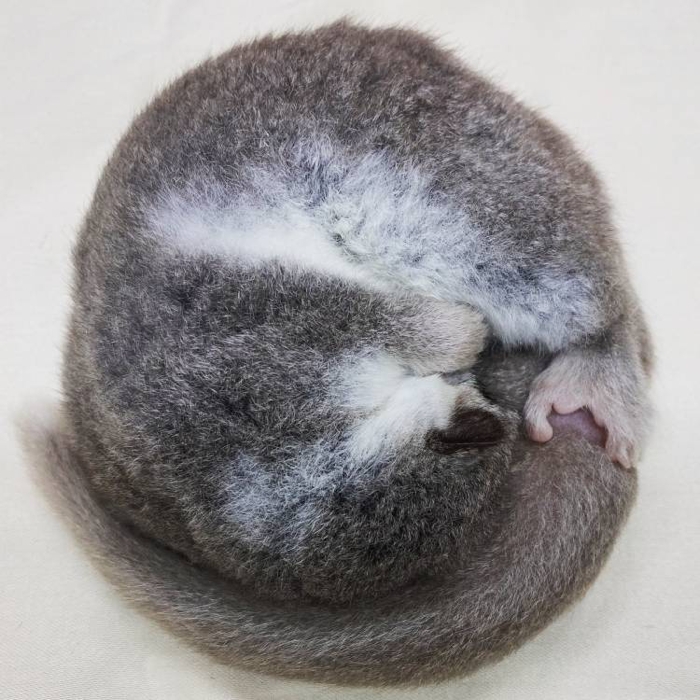Spring is coming to North America and scientists are quietly excited. Little dwarf lemurs are waking up after months in hibernation – the first time these furry fat-tailed animals have gone into a long hibernation in captivity.
New research, which recreated seasonal conditions to coax captive dwarf lemurs into hibernation just like their wild kin do in western Madagascar, suggests these animals can return to their wild hibernating ways after decades of breeding in captive care.
"We've been able to replicate their wild conditions well enough to get them to replicate their natural [hibernation] patterns," said Erin Ehmke, a primate biologist at the Duke Lemur Center where the study was conducted.
The study findings should not only help improve care for dwarf lemurs in captivity but also gives scientists new ways of studying the biological trickery hibernating animals use to weather environmental extremes.
 (Lydia Greene)
(Lydia Greene)
Fat-tailed dwarf lemurs are master hibernators, spending up to seven months hibernating each year depending on conditions. It's an extreme survival tactic used by many mammals for going on 250 million years.
Dwarf lemurs, which use fat stores in their tails to last out the Madagascan winter, are actually our closest hibernating primate relative. To save energy in hibernation, their heart rate almost flatlines, their body temperature plummets, and their breathing slows to the point where scientists have observed one hibernating lemur go 21 minutes between breaths.
Studying animals that hibernate is more than an envious curiosity for scientists, as it might actually someday improve human health. Though it remains in the realm of science fiction for now, researchers are looking at the science of hibernation to find ways to help people survive long-distance space flights, make surgery safer, and possibly even prevent disease.
In this study, the research team monitored eight dwarf lemurs, the descendants of a few wild animals brought to the Duke Lemur Center decades ago, for a months-long artificial winter to see whether these animals could hibernate akin to their wild counterparts.
"Hibernation is literally in their DNA," said Duke University primate biologist Marina Blanco.
Yet despite best efforts to care for captive animals, they tend to behave differently to their wild pals, especially when it comes to hibernation – something which scientists have known for quite some time, and is most likely due to the unnatural conditions in climate-controlled zoo habitats with food aplenty.
Studies have shown that captive dwarf lemurs, for example, drop into far shorter bouts of shallow hibernation, called torpor, than wild lemurs do, with these energy-saving sleeps rarely lasting longer than 24 hours in captivity.
Whether this is just a temporary disruption to hibernation patterns or because captive lemurs have lost the physiological capacity to hibernate still remains a bit of a mystery.
The researchers showed that dwarf lemurs are indeed capable of sustaining months-long hibernation in captivity, supporting the idea that hibernation is biologically hardwired in these animals and can be reactivated under the right conditions.
Before bunkering down, the animals were fitted with radio transmitters to measure their heart rate and skin temperature, and housed in snug temperature-controlled enclosures with wooden boxes designed to mimic tree hollows.
The researchers gradually adjusted the lights to match the short winter-like hours in Madagascar, turned the thermostat dial down to 10 degrees Celsius (50 degrees Fahrenheit), and limited the animals' food – then watched and waited.
From October to February, the lemurs spent nearly three-quarters of their time in metabolic slow-motion: curled up, cool to the touch, barely moving or breathing for up to 11 days at a stretch, showing little interest in food.
Remarkably, few studies before this have experimented with restricting food to captive animals – even though hibernation is an extreme energy-saving strategy that animals use to survive when food gets scarce.
"That males fed more times, expressed short torpor bouts more often, and stayed in torpor fewer hours overall than did females (though our sample size is too small to be conclusive) suggest[s] that feeding may have affected torpor dynamics to a degree," the researchers wrote in their methods paper.
The lemurs, now rousing from their months-long slumber, are looking healthy, the researchers have reported, with the animals' heart rates bouncing back from 8 beats per minute (bpm) to around 200 bpm – and with it, their appetites.
With the animals recovering well, researchers are looking to plan more studies in the lead-up to next year's winter, since long-lived lemurs might also harbor secrets to aging well.
"Until now, if you wanted to study hibernation in these primates, you needed to go to Madagascar to find them in the act," Blanco said. "Now we can study hibernation here [in captivity] and do more close monitoring."
The research was published in Scientific Reports.
"captivity" - Google News
March 16, 2021 at 12:24PM
https://ift.tt/3qSjaIs
Adorable Snoozing Lemurs Are Teaching Scientists The Secrets of Hibernation - ScienceAlert
"captivity" - Google News
https://ift.tt/3b01anN
https://ift.tt/3dbExxU
Bagikan Berita Ini















0 Response to "Adorable Snoozing Lemurs Are Teaching Scientists The Secrets of Hibernation - ScienceAlert"
Post a Comment